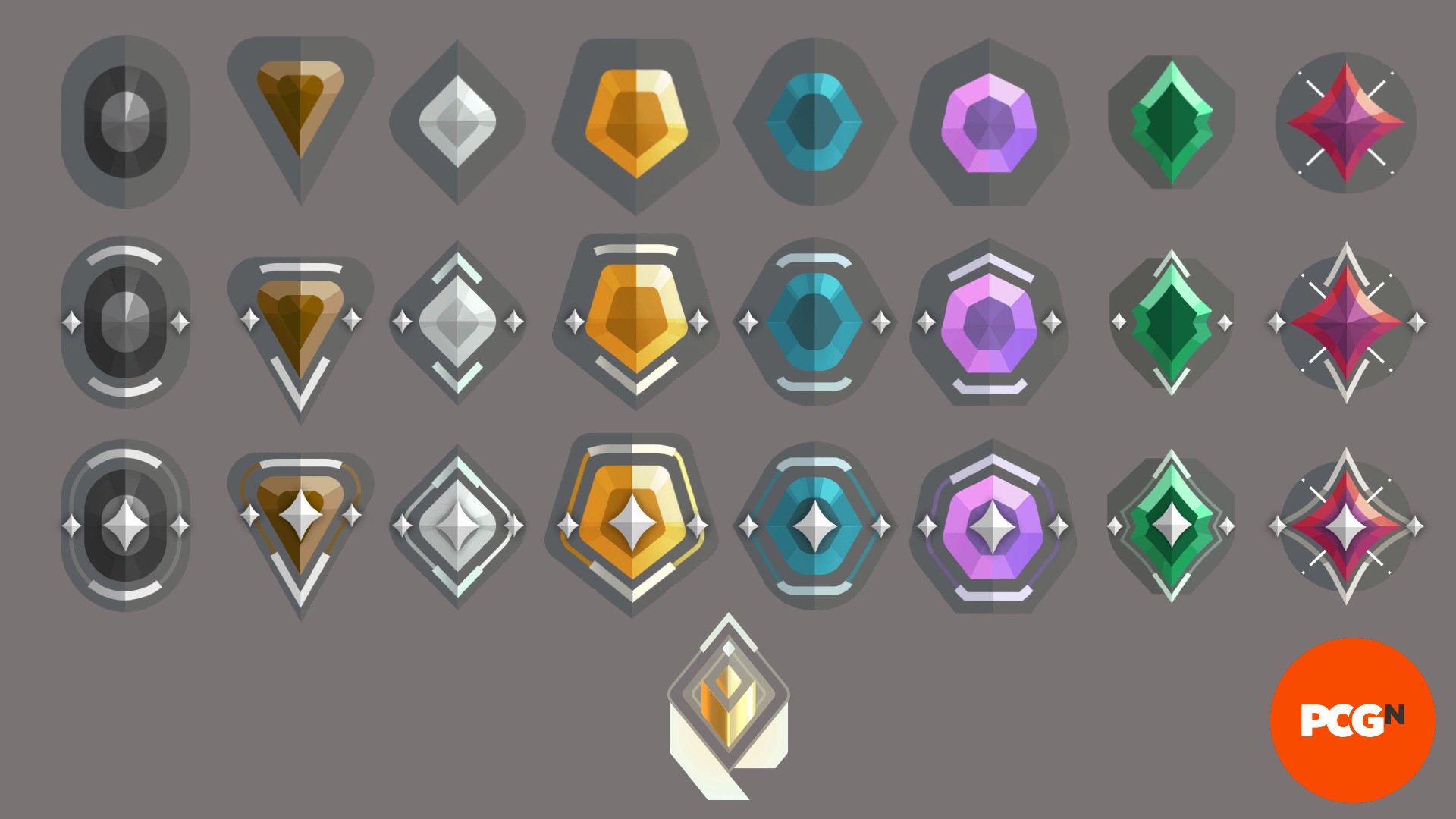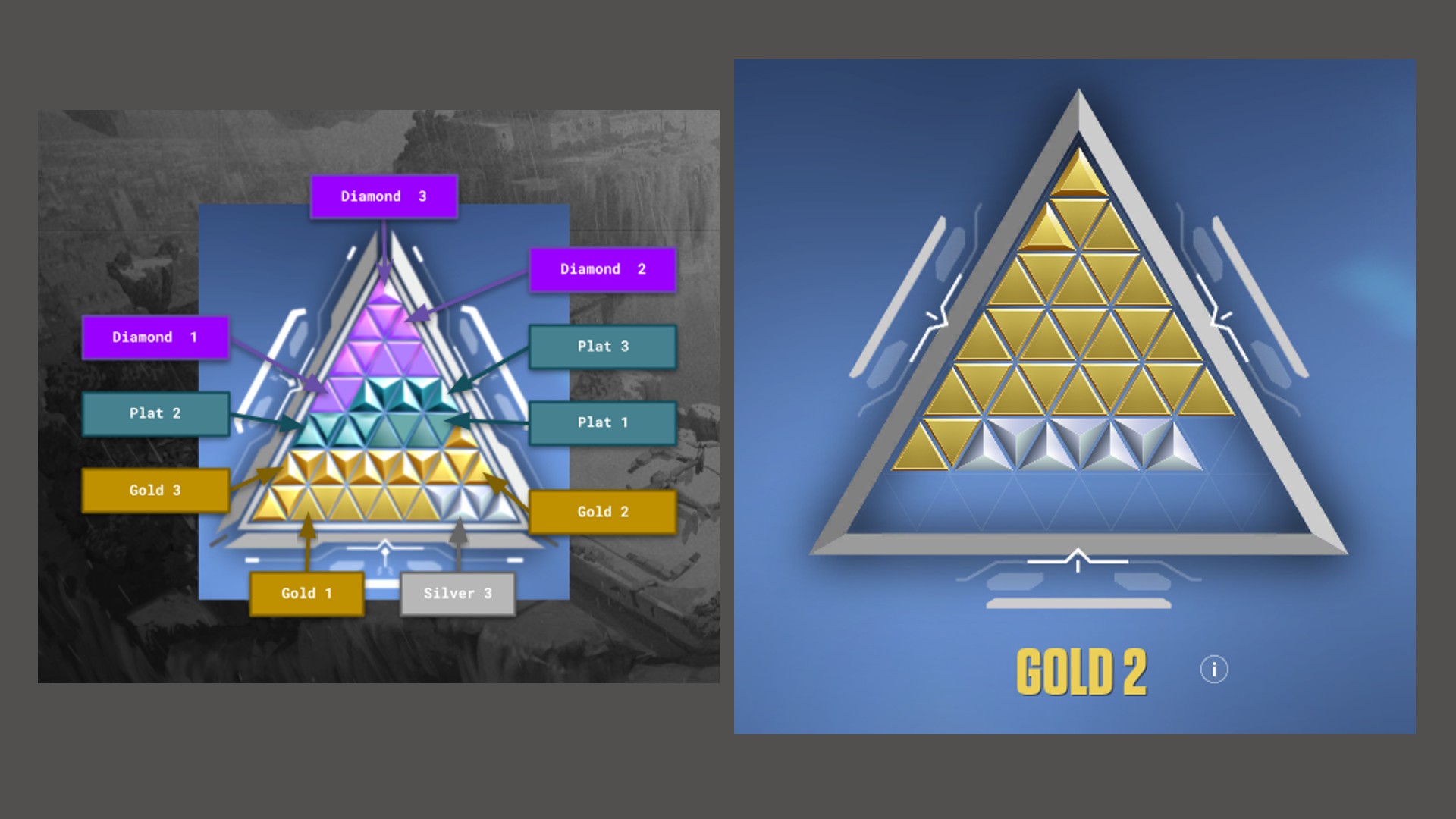
What are Valorant ranks? We’ve taken a deep dive into the Valorant ranking system, to show you how they work, and what the current distribution is. Looking at these figures, we can glean all kinds of information, like where you sit against the average player, as well as how much time and energy you’ve put into the FPS.
Like all competitive FPS games, Valorant has a couple of different ways it measures ranking progress and the overall rating of players against each other. Each player has an overall Valorant rank, but there’s also a dedicated ‘Act rank’ for each act. On top of that, there’s also a concept called ‘rank rating’, which is connected to MMR. Here’s everything you need to know about Valorant ranks, the current rank distribution, and competitive play.
All Valorant ranks in order
Here is a complete list of Valorant ranks:
- Iron 1
- Iron 2
- Iron 3
- Bronze 1
- Bronze 2
- Bronze 3
- Silver 1
- Silver 2
- Silver 3
- Gold 1
- Gold 2
- Gold 3
- Platinum 1
- Platinum 2
- Platinum 3
- Diamond 1
- Diamond 2
- Diamond 3
- Ascendant 1
- Ascendant 2
- Ascendant 3
- Immortal 1
- Immortal 2
- Immortal 3
- Radiant
Valorant Act rank
While your rank is an overall (and accurate) reflection of your skills and abilities, you also earn a separate Act rank as you play through each act. Your Act rank is officially the highest-ranked win, which Riot likes to call your “proven skill”.
There’s a hollow triangular badge you fill in during an act, with miniature colored triangles being slotted in as you play. Regardless of how many different rank colors the badge gets filled up by, only the topmost triangle – your highest-ranked win – will define your Act rank.
This is also what governs the reward you’ll receive at the end of the Act – even if you’ve spent the majority of your time in Gold, if you have a win in Diamond 1, you’ll receive the Diamond rewards. Your Act rank resets between ranks, but your previous MMR is taken into account as you play your placement matches for subsequent acts.
Valorant rank distribution 2024
Rank distribution is important in any competitive shooter, and Valorant is no exception. Riot itself has shared information on this as far back as Episode 3 Act 1, where the studio said it was concerned there were too many people in the lower ranks and not enough making it through to the higher tiers.
In Septmeber, stats have skewed significantly towards the higher ranks once again, particularly visible all that way up Immortal. This suggests Valorant has had a particularly good month of player consistency.
Valorant rank distribution for October 2024 (vs September 2024):
- Iron: 7.7% (7.7%)
- Bronze: 19.3% (19.3%)
- Silver: 23.6% (23.6%)
- Gold: 21.1% (21.1%)
- Platinum: 14.4% (14.4%)
- Diamond: 8.9% (8.9%)
- Ascendant: 4% (4%)
- Immortal: 2.2% (2.2%)
- Radiant: 0.031% (0.031%)
Stats from esportstales.com
Valorant rank placements and restrictions
Since Episode 4 Act 1, you need to have an account level of at least 20 to earn ranks in Valorant’s competitive mode. Once you’ve hit that threshold, you can engage in ranked play. At the start of every episode, you need to play five placement matches, but for every Act 2 and 3 within an episode, you only need to play one placement match – your rank resets at the start of every Act.
Valorant is a game that tries to promote competitive play between teams, although Riot has also tried to be generous with allowing friends to play with each other, even if there is a rank disparity. When it comes to playing with friends, there are some rules to keep in mind:
- Groups of four are not allowed, to prevent solo players from getting picked on.
- Groups of two or three have to stay within the rank disparity requirements.
- Groups of five have no restrictions, although depending on what ranks a five-stack has, will affect your rank rating gains and losses.
In terms of rank disparity, there are only restrictions for groups of two or three players. If the lowest person in the team is Iron or Bronze, then the highest can be no higher than Silver (any tier). If the lowest is Silver, then the highest can be no higher than Gold (any tier). If Gold is the lowest, then Platinum is the highest – again, any tier.
If the lowest rank in the team is Platinum, Ascendant, Immortal, or Radiant, then the highest player can be no more than one level higher – so if the lowest is Platinum 2, then the highest can only be Diamond 2. Five-stack parties ignore disparity restrictions, although depending on how big the disparity might be, there may be significant rank rating penalties. You can go to the official Valorant competitive FAQ for more details on this.
That’s everything you need to know about Valorant ranks. For more Valorant guides, check out our Valorant tier list for the best characters, our Valorant crosshair codes guide to kit out your sites like your favorite pro, and then our guide to the Valorant Night Market for those discounted skins. For a break from Valorant and those pro plays, why not check out some of the best PC games at your fingertips right now?



